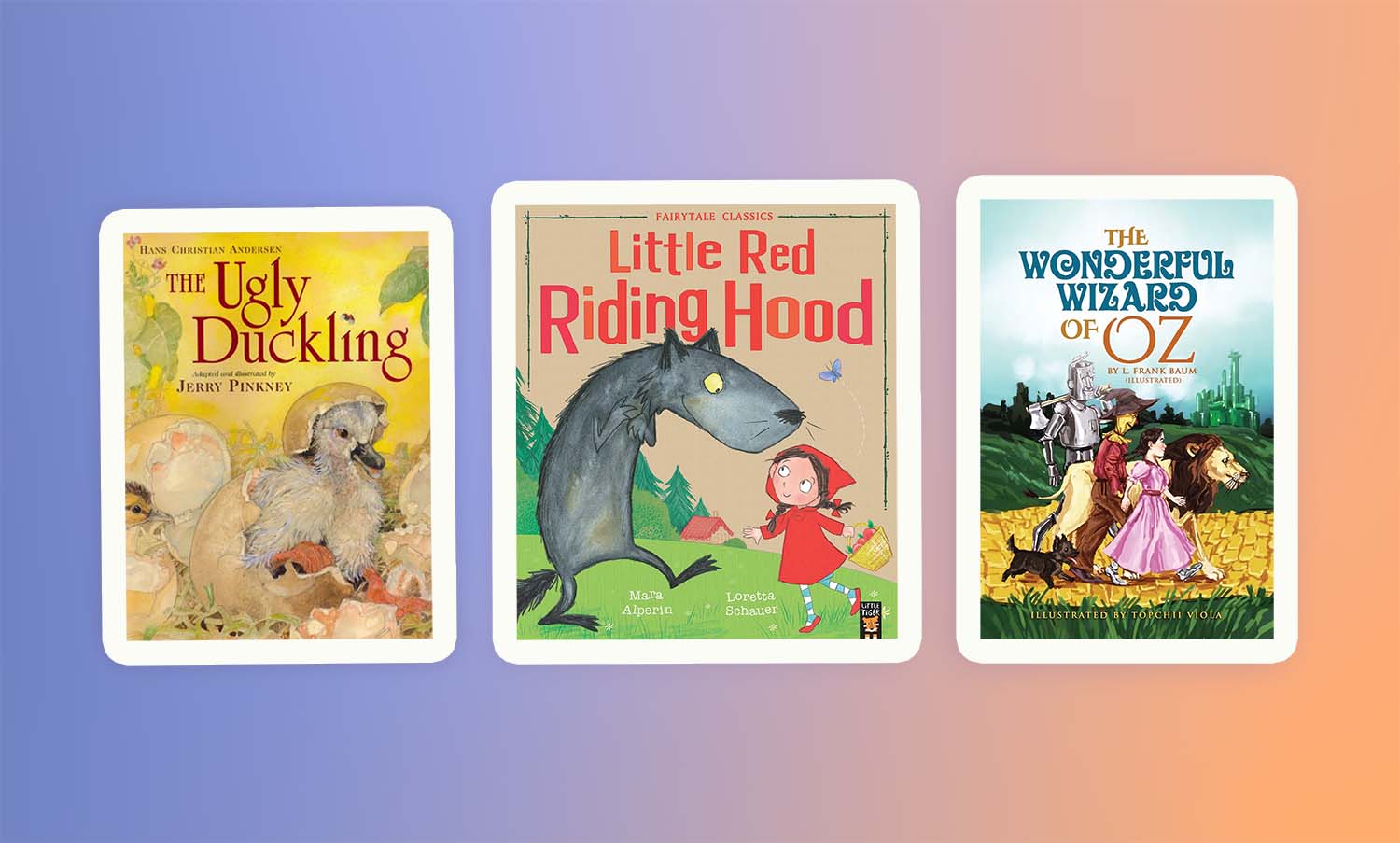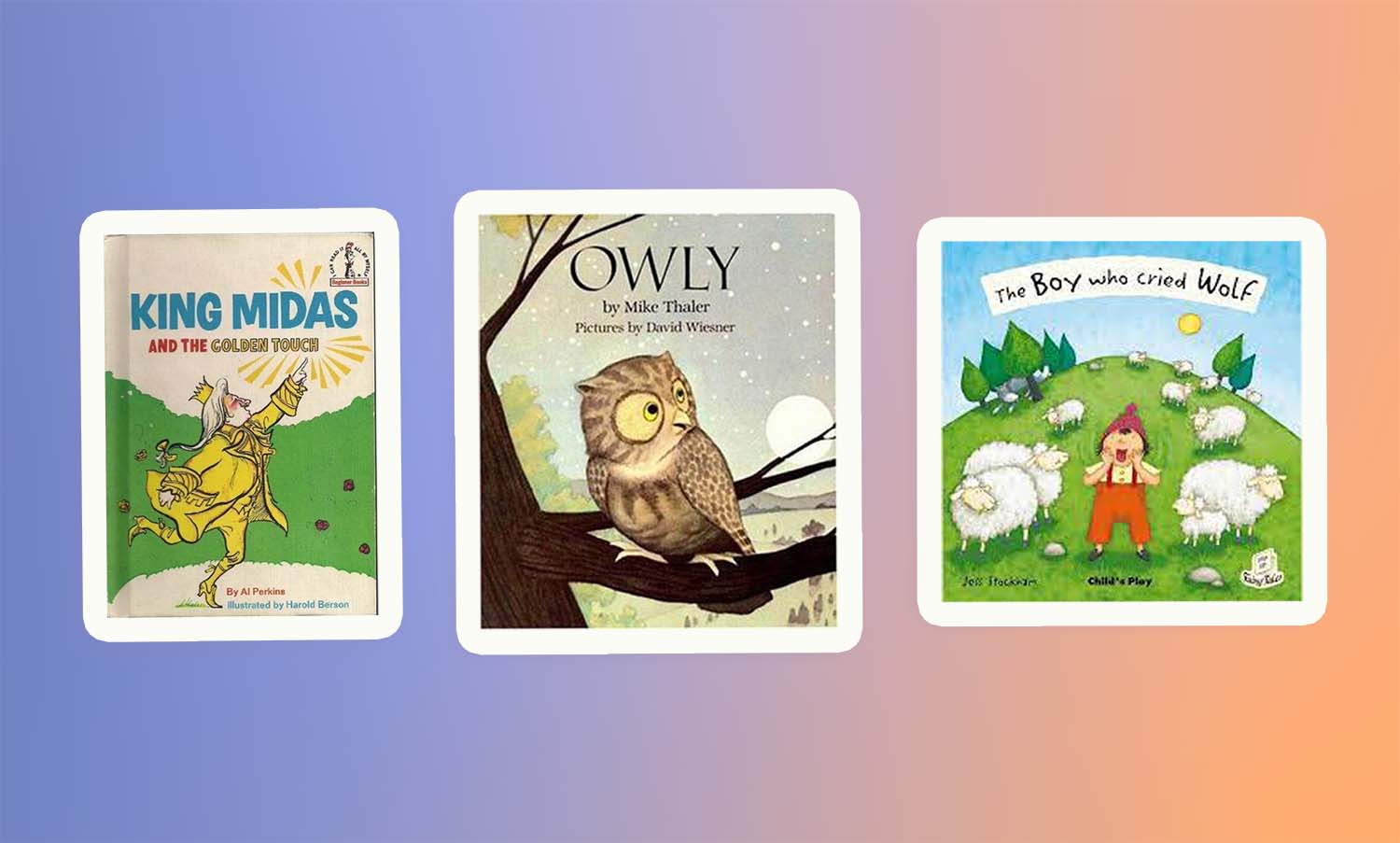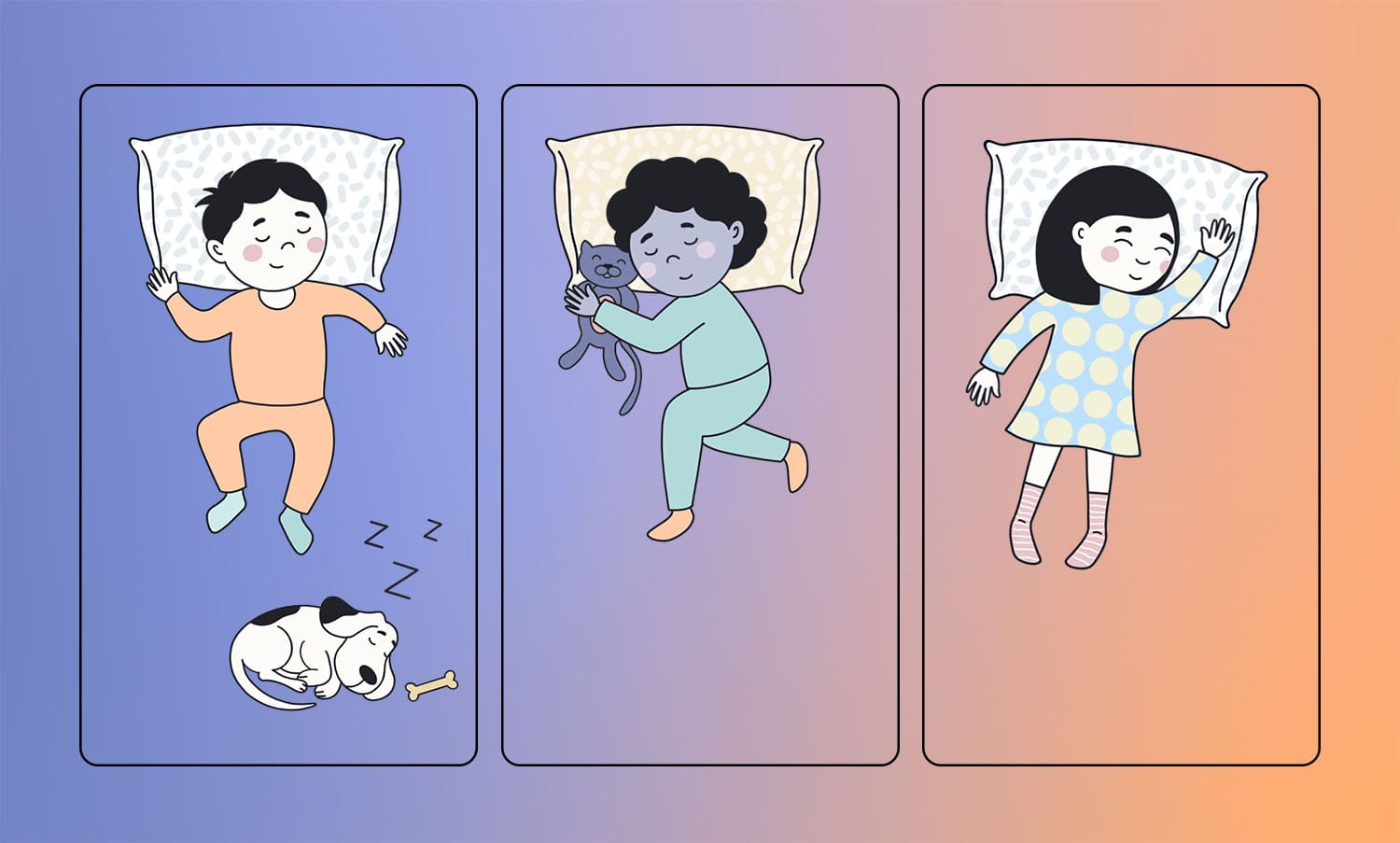If you think back to your childhood, you might remember the soothing ritual of having your parents read you a bedtime story. From fairy tales like Cinderella and Beauty and the Beast to fables like King Midas and His Golden Touch and Peter Rabbit, there are a host of popular stories to choose from. Beyond their engaging plots, bedtime stories have a number of benefits for children, including improving vocabulary, inspiring creativity, and forming deeper familial bonds.
To learn more about our readers’ favorite bedtime stories, Mattress Clarity sent out a survey to determine the most popular stories and why readers enjoyed them so much. You’ll see some of their responses and personal anecdotes as well.
Below you’ll find information on benefits of reading bedtime stories, lists of stories ranging from the classics to those that explore good morals and diversity, recommendations from educators, and tips for making bedtime stories more fun!
Jump To
Benefits of Bedtime Stories | Classic Bedtime Stories | Bedtime Stories with Good Morals | Bedtime Stories Celebrating Diversity | Our Readers’ Favorites | Recommendations from Educators | Tips & Playlist
Benefits of Bedtime Stories
Did you know that a child’s reading level by third grade statistically determines how well they’ll do in school in the future? One of the best ways you can improve your child’s literacy is by reading to them. Bedtime stories are a tried and true method for improving children’s vocabulary, expanding their imagination, practicing patience, and even teaching them empathy and understanding through the stories’ morals. Some other benefits of reading bedtime stories include:
- The repetition and structure of an established routine will help children feel safe.
- You’ll form a deeper bond between parent and child.
- It helps children transition from a busy day to a quiet night.
- Your child will likely open up about their thoughts and feelings.
- It stimulates their imagination.
- A consistent bedtime routine helps children get to sleep and results in better daytime behavior, a study found.
Bedtime stories can be a powerful tool for helping your child establish a healthy nighttime routine. Sarah Miller, Founder of Homeschooling 4 Him, says “Routines give a sense of comfort and familiarity, especially for younger children who don’t understand the concepts of time. She also highlights how it can improve their sleep: “Reading a bedtime story at the same time every night, or even reading the same bedtime story every night, can send helpful signals to a child’s brain that it is time to get ready for sleep.”
Research suggests that the best time to start reading to your child is around 8 months. Though your child may not understand what you’re saying, they can start to comprehend the emotions associated with stories. Additionally, it’s important to note that there is an optimal way to read bedtime stories — when your child is old enough to respond, you want to be sure to ask them open-ended questions about the stories to boost their engagement.
Classic Bedtime Stories
There are a number of classic bedtime stories that have been shared through generations. Many can recite these stories (or the gist of them) by heart. Take a look at some of the most well-known stories below.
Goldilocks and the Three Bears
This fairy tale originated in Britain in the 19th century. It’s about a little blonde-haired girl who finds an empty house in the woods. Though she doesn’t know it yet, the home belongs to three bears: Papa Bear, Mama Bear, and Baby Bear. Goldilocks tries their porridge, sits in their chairs, and goes to lay in their beds. When the bears come home, a frightened Goldilocks escapes in the nick of time.
The Ugly Duckling
The Ugly Duckling is a Danish fairytale written by celebrated children’s author Hans Christian Andersen in 1843. It tells the story of a duckling who was born “uglier” than his siblings. They ostracize him, and he spends a year looking for a home, unable to find where he belongs. When he’s nearly given up, he throws himself at a pack of beautiful swans, expecting them to kill him. However, the swans accept him as one of their own, and when he sees his reflection, he realizes he’s grown into a beautiful swan himself.
Jack and the Beanstalk
This British fairy tale was originally called The Story of Jack Spriggins and the Enchanted Bean in 1734. It’s about a boy who trades his poor family’s only cow for magic beans. Though his mother is enraged at his foolish purchase, Jack plants the seeds and they grow into a gigantic beanstalk that reaches above the clouds. Jack climbs it to find the home of a giant. Though the giant can sense Jack’s presence, shouting “Fe Fi Fo Fum, I smell the Blood of an Englishman!” Jack is able to escape with the giant’s treasures, including a goose that lays golden eggs. The giant tries to chase him down the beanstalk, but Jack is able to cut it down before the giant can reach him.
The Wonderful Wizard of Oz
Published in 1900, the Wonderful Wizard of Oz is a children’s book written by L. Frank Baum and illustrated by W. W. Denslow; it was later adapted into a film in 1939. It’s about a girl named Dorothy who lives in Kansas. When a tornado sweeps up her home, Dorothy finds herself transported to the land of Oz. Intent on finding a way home, she follows a yellow brick road, on which she picks up other characters looking for something. This includes a cowardly lion, a tin man, and a scarecrow. They all head to Oz to find the wizard, who they believe can solve their problems. However, the wizard turns out to be just an ordinary man. Still, together they are able to find what they were looking for.
Beauty and the Beast
This fairy tale originated in France in 1740 where it was originally published as La Belle et la Bête. Written by Gabrielle-Suzanne Barbot de Villeneuve, it tells the story of a beautiful young girl, Beauty, who is forced to live in a castle with the Beast after her father plucks a rose from the Beast’s castle. The Beast plans to marry Beauty, but she only sees him as a friend. It is only after the Beast dies of shame, and beauty cries for her lost friend, that he is transformed into a prince. He tells Beauty that he was cursed by an enchantress for his selfish ways, and only true love could break the curse.
Cinderella
Though this story has origins in ancient Greece, the first literary version was published in Italy by Giambattista Basile in 1634. In this fairy tale, a beautiful young girl named Ella tragically loses her mother. Her father remarries an evil stepmother, who has two cruel daughters. Tragically, her father dies soon after the marriage. Ella’s stepmother and stepsisters make Ella their maid, giving her the nickname Cinderella, since she is often covered in cinder from her work. When the family is invited to the royal ball, Cinderella cannot go because she has nothing to wear.
However, a fairy godmother appears and makes her a beautiful dress and carriage; the only catch is that she must be home by midnight. She arrives at the ball and catches the eye of the prince. They dance through the night, but when the clock gets close to midnight, Cinderella hurries away, leaving a glass slipper behind. The prince finds her slipper and vows to find the woman it belongs to. He goes to each house until he finds Cinderella, who becomes his princess.
Mattress Clarity reader Crystal Walker loves this story because “It teaches that dreams can come true.”
Little Red Riding Hood
The earliest known written version of this fairy tale was by Charles Perrault in 17th century France. Little Red Riding Hood is about a young girl who must travel through the woods to deliver food to her sickly grandmother. Along the way, a wolf stalks her path, and asks her where she is going. Foolishly, she tells the wolf she is going to her grandmother’s house. The wolf manages to get to her grandmother’s house first and eats her grandmother. The wolf then disguises himself as the grandmother. When Little Red Riding Hood arrives at her home, she is initially fooled by the disguise, long enough for the wolf to convince her to enter. Finally, he eats the young girl as well.
The Tale of Peter Rabbit
Written and illustrated by English writer Beatrix Potter in 1902, The Tale of Peter Rabbit is about a mischievous bunny whose mother warns him and her other three rabbits, Mopsy, Flopsy, and Cottontail, not to enter Mr. McGregor’s vegetable garden. She tells them that their father did so, and Mr. McGregor made him into a pie. Though his siblings follow their mother’s advice, Peter goes into the garden anyway and gorges on vegetables. Mr. McGregor spots him and chases him away. Peter escapes, but his clothes are left behind; Mr. McGregor ends up using his clothes as a scarecrow.
Bedtime Stories with Good Morals
Many bedtime stories, particularly fairy tales, are written with morals that are meant to teach the audience something. They show that actions have reactions, and when we behave badly, we often have to suffer the consequences. By reading such stories to young children, you can help teach them valuable lessons that they can apply to real life situations. Take a look at some popular bedtime stories with good morals.
The Boy Who Cried Wolf by Aesop
This story is about a boy who continually says he’s spotted a wolf when he hasn’t, just to get attention. However, when a real wolf finally does appear, no one comes to his aid, as they no longer believe him.
Moral: When you don’t tell the truth, people won’t trust you, even when you are telling the truth.
Mattress Clarity reader Brenda likes this story because “It teaches a very valuable lesson about lying about serious situations.”
King Midas and His Golden Touch by Nathaniel Hawthorne (adapted from myth)
King Midas wishes that everything he touches would turn to gold. He is initially delighted when his wish comes true, but soon he discovers that it is a curse rather than a gift, as he can’t even touch food without it turning into gold.
Moral: Greed won’t buy true happiness
Wise Old Owl author unknown
An owl hears more the less he speaks, and so he speaks less to hear more.
Moral: When you are silent and listening, you will learn more
The Tortoise and the Hare by Aesop
A hare makes fun of a slow tortoise, and so the tortoise challenges him to a race. The hare accepts, but since he believes the tortoise will be so slow, he decides to take a nap. Slowly but steadily, the tortoise continues on, passing by the sleeping hare. The hare wakes up too late, and the tortoise wins the race.
Moral: Slow and steady wins the race
The Golden Egg by Aesop
A merchant living in a village with his wife and children has a hen that lays one golden egg per day. The merchant decides this is not enough; he wants all the eggs at once. He decides to kill the hen to get all the eggs inside it, but he realizes after he kills it there are no eggs inside, and he has no way to get more golden eggs.
Moral: Greed will get you nowhere
“My mother used to read me Aesop’s Fables when I was little and there’s always a lesson to be learned” says Mattress Clarity reader Kimberly Pikna.
The Farmer and the Well by F. K. Waechter
A farmer in need of water buys a well from his neighbor. However, his tricky neighbor won’t give him the well’s water, telling him he only bought the well, not the water. The farmer seeks counsel from his emperor’s courtier, who tells the neighbor that if the farmer cannot have the water, then the neighbor must remove all the water from his well.
Moral: Cheating will come back to bite you
The Wolf who Wanted to Change his Color by Orianne Lallemand
A wolf decides he is unhappy with his natural color, so he tries a series of methods to change his coat. Each method fails, and in the end, he realizes that his original color suited him best.
Moral: Accept yourself for who you are
The Dragon Who Couldn’t Puff by Chelsea Burgess
A house dragon wants to learn how to breathe fire like his mother and sister, but when he tries, he can’t. His mother teaches him that he’ll need to try many times before he is successful. At first he doesn’t want to keep trying, but he learns that to do it right, he’ll need to.
Moral: Practice makes perfect
Guapo’s Giant Heart by Janet Zappala and Wendy Perkins
Based on the true, heartwarming story of a baby calf with no place to live, until a kind human gives him a loving home. With a safe place to rest his head – along with plenty of food and love – Guapo keeps growing and growing! The story introduces young readers to Guapo and explores how despite his large appearance, he’s really quite gentle and kind.
Moral: Lean into one another despite differences and appreciate everyone
Bedtime Stories Celebrating Diversity
Bedtime stories that highlight diversity can be a great way to teach children to accept everyone’s differences. These stories show that everyone deserves to be treated with the same respect and kindness. Check out these bedtime stories that all celebrate diversity.
Lola at the Library by Anna McQuinn
Lola is a young African American girl who loves to visit the library with her mother to read new books, listen to the librarian, and meet a diverse group of friends.
Baby Goes to Market by Atinuke
In Nigeria, a baby goes to market with his mother. The busy market is full of different vendors, who give him things to add to the basket. This book introduces children to numbers, addition, and subtraction.
Mommy, Mama, and Me and Daddy, Papa, and Me by Lesléa Newman
These picture books illustrate children in loving families with gay parents.
Julian is a Mermaid by Jessica Love
Young Julian spies colorful women on a train and wants to dress up like them. His newfound identity challenges his abuela’s ideas, and illustrates that individuality doesn’t have to be defined by gender norms.
Marisol McDonald Doesn’t Match by Monica Brown
Marisol is a Peruvian-Scottish biracial girl, with brown skin and red hair. She doesn’t like anything that matches, including clothing and food. Her mismatching style confuses others but makes perfect sense to Marisol.
Sesame Street – We’re Different, We’re the Same by Bobbi Kates
Elmo and the other Sesame Street puppets teach children that we are all the same on the inside, but our outer differences are what make us unique. Our different races, religions, and customs create diversity — something to celebrate.
Say Hello! by Rachel Isadora
Carmelita lives in a diverse neighborhood full of different cultures and languages. She learns to say hello in many of these languages, and her dog Manny greets everyone with a happy woof.
Daddy Christmas and Hanukkah Mama by Selina Alko
This holiday book is about young Sadie, who has a Christian father and Jewish mother. Her blended family celebrates both holidays and their unique traditions.
Everywhere Babies by Susan Meyers
This board book highlights the diversity of babies around the world and shows that they are loved and cared for, no matter where they come from.
Chocolate Me! by Taye Diggs
A little boy with dark skin and curly hair is teased for how he looks. He tells his mom he wishes he could look like everyone else, and she shows him how he is unique and special in his own way.
Mama Panya’s Pancakes by Mary Chamberlin
In a Kenyan village, Mama Panya’s son Adika invites all his neighbors to have pancakes at his house, and Mama Panya must figure out how to feed them all.
Little Red and the Very Hungry Lion by Alex T. Smith
A little African girl named Red wants to visit her sickly auntie, but she must pass by wild animals, including a hungry lion. The lion wants to eat Red, but she tricks him and convinces him to eat doughnuts instead.
Mattress Clarity Readers’ Favorite Bedtime Stories
We surveyed our readers about their favorite classic bedtime stories for kids, and the top voted story is Goldilocks and the Three Bears with 38.7% of votes! The second and third runners up are Little Red Riding Hood with 36% of votes and Cinderella with 29.3% of votes.
Take a look at some of the other stories beloved by Mattress Clarity readers:
Little Orphan Annie by Harold Gray
“I was a scared, timid child. I identified with Little Orphan Annie. I liked the ending. It taught me to be strong no matter what is being thrown at me.” – Carol Marshall
The Giving Tree by Shel Silverstein
“Teaches altruism and gives perspective on aging to young children.” – Mattress Clarity reader
The Elves and the Shoemaker by the Brothers Grimm
“A great story about helping without looking for recognition” – Kathy Agate
The Very Hungry Caterpillar by Eric Carle
“The illustrations are classic and have withstood the test of time, and it spreads a positive message of people’s relationship with food and eating.” – Anthony O’Reilly
Where the Wild Things Are by Maurice Sendak
“It teaches you not to judge others by their appearance (celebrating diversity) as well as obey and appreciate your parents.” – Carley Prendergast
Love You Forever by Robert Munsch
“It teaches unconditional love between generations. Love from a parent to a young child then an adult child to their elderly parent.” – Lori Viator
The Rainbow Fish by Marcus Pfister
“It’s always good to be a generous person but don’t spread yourself too thin.” – Kristin Lovett
Recommendations from Educators
There was a Lady who Swallowed a Fly by Rose Bonne and Alan Mills
Recommended by Aziz Khatri, Creator of Bablr Early Learning
“We recommend this story because of its rhyming nature, most kids really enjoy it. Using common animals which are known to most kids starting with toddlers, it weaves a sequential narrative which very naturally encourages the child to predict what’s happening next – a great exercise for early brain development and neural growth.”
The Big Book of Animal Stories by Thornton Burgess
Recommended by Sarah Miller, Founder of Homeschooling 4 Him
“This book has short chapters, which makes it perfect for bedtime and for kids with short attention spans. The lovable animal characters are easy for kids to relate to and there are lots of great life lessons throughout.”
How the Moon Regained Her Shape by Janet Ruth Heller
Recommended by Janet Ruth Heller, former teacher and principal
“How the Moon Regained Her Shape (Arbordale, 2006; 6th edition 2018) is a fiction picture book about the solar system and bullying for young children, their families, their schools, houses of worship, sports teams, and other organizations that help children. In addition to teaching children about coping with bullies, this book would be a good start on STEM activities for kids.”
The Lorax by Dr. Seuss
Recommended by Vanessa Fassbinder, Co-founder of Child Insider
“The Lorax by Dr. Seuss is my favorite bedtime story for kids. Not only is it a great book to read to toddlers, but it’s also excellent for kids who are around ten years old. Its whimsical characters and the classic Seussical wordplay make it a stellar read. But it’s the story’s message that is highly important. The book highlights that respect for the environment and all living creatures is what’s needed to preserve the planet for future generations.”
Goodnight Moon by Margaret Wise Brown
Recommended by Michelle Moyal, CCC/SL, Clinical Director & Founder of Therapy Works Together
“It’s rhythmic and repetitive (great for learning new vocabulary), just a bit odd but stimulates the imagination. The illustrations are incredible for prompting a discussion with a child and talking about what they see.”
History of Bedtime Stories and How They’ve Changed Over Time
Storytelling is a tradition that dates back to the start of human linguistics, and thus bedtime stories may have been repeated to children for thousands of years. However, the term “bedtime story” was coined by Louise Chandler Moulton, who wrote Bed-Time Stories in 1873. The ritual of reading bedtime stories gained popularity in the 19th and 20th century, when people began to believe in the benefits of soothing nighttime routines for children.
Bedtime stories range in category from ancient myths to fairytales. Some of the oldest bedtime stories are by Aesop, a storyteller who lived in Ancient Greece between 620 and 564 BCE. His stories are especially popular as they contain morals, or lessons to be learned. These stories, like The Tortoise and the Hare or The Big Bad Wolf, show children the importance of doing the right thing.
Another key benefit of bedtime stories is their ability to forge stronger connections between children and parents. They allow families to spend more quality time together, and create memories that will last a lifetime. In addition, they help spark children’s imagination and creativity. Listening to stories allows them to create a unique picture in their minds — something they won’t get by watching TV or playing on an iPad.
Tips to Make Reading Bedtime Stories Fun
It can be a challenge to get children to sit still and listen. Take a look at some of these tips to get your child more engaged in the story.
- Use big emotions and expression
- Ask questions
- Change voice to match characters
- Show excitement and joy
- Make sounds and noises, and allow the child to imitate you!
- Children learn from repetition – don’t worry about reading the same story repeatedly
Final Thoughts
Bedtime stories can be a fun and educational bonding activity for you and your children. Whether you choose fanciful fairy tales or moralistic fables, you’ll be helping your child improve their vocabulary and expand their imagination. You’ll also be establishing a nighttime routine, which makes children feel safe and can help them fall asleep faster. Remember to use helpful tips like asking questions and showing excitement to help keep them invested in the story. Happy reading!
P.S. Don’t forget to check out our Bedtime Stories Playlist on Spotify!





